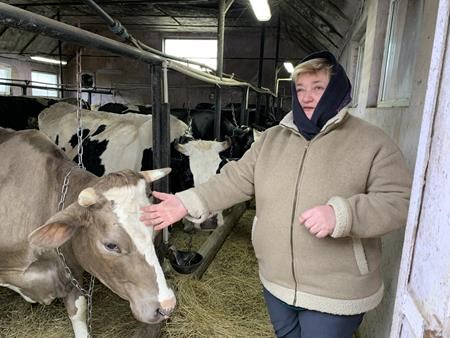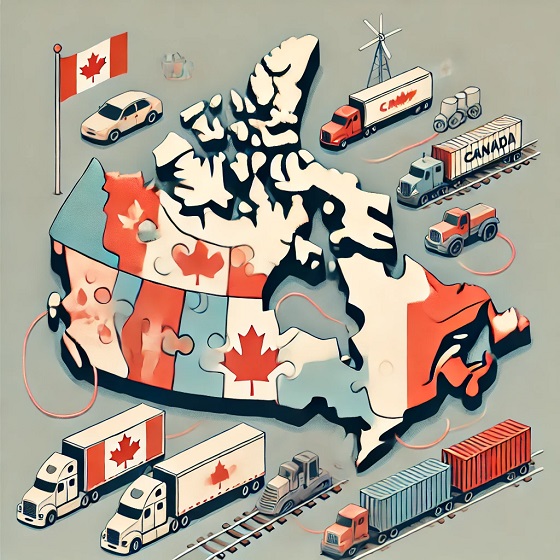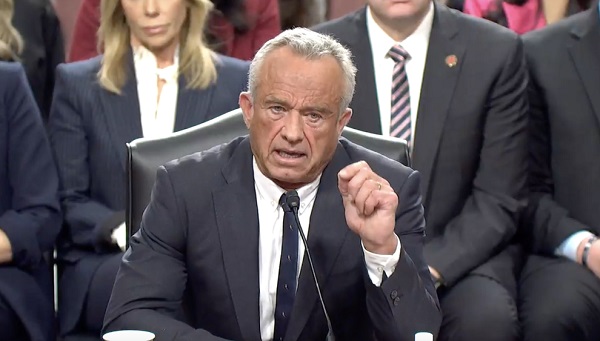Alberta
Canadian dairy plant becomes unlikely symbol of defiance for Ukrainian farmers

KRASNE, Ukraine — The cows on Lyuba Pastushok’s farm are like her “cheeky children,” she explained in Ukrainian as she walked among her growing herd, gently cooing to them and softly petting their heads.
A few years ago there were only five cows on her small family operation in Holoskovychi, a rural community an hour and a half east of the nearest city of Lviv, in western Ukraine.
Now she tends to 25 cows, six of which she bought after Russian forces invaded the country.
Wrapped up against the cold with a kerchief tied over her head, the Ukrainian matriarch pointed out each by name, her voice full of motherly pride.
She credits her success to the creation of a Quebec-style co-op in her community, and said a new Canadian dairy plant in the area is likely to help the local industry grow even more.
The project has become an unlikely symbol of defiance in the face of the Russian invasion.
Russia is stepping on Ukrainian farmers, Pastushok said through a translator during an interview in her farmhouse kitchen, “but we are developing in spite of them. We are who we are — Ukrainians.”
The $3-million dairy plant, funded by Global Affairs Canada, will produce milk, yogurt, sour cream and hard and soft cheeses using milk from the local dairy co-ops. Those co-ops will also have a stake in the management of the plant, which will employ 30 to 40 people.
Construction was already well underway when war broke out last year and disrupted every aspect of life in the now embattled country.
Investors at first shied away from putting their money into a project in conflict zone, said Camil Côté, the project officer for SOCODEVI, the Montreal-based development agency spearheading the project.
The invasion put a stop to the work for about three months, until Canada offered another $2 million to get it started again.
“Just like the whole of Ukraine, we survived the winter,” Côté said in an interview from Nicaragua.
“We have (had a) few dangerous situations near the plant,” said Andriy Blinovskyy, who manages the project on behalf of a corporation of local dairy co-ops called Nabil.
“We have missile explosion near the plant, when the electricity transformer station was destroyed maybe 10 kilometres from the plant.”
That explosion late last year forced workers to continue building through the winter without heat, using a generator for power.
When it’s up and running, the plant will mainly supply the Lviv region with locally produced products. The equipment and the brand new, gleaming milk tanks in each room carry Canadian flags.
“The factory is perceived as our own. Our country, our home, our family,” Pastushok said.
SOCODEVI first brought the Quebec-style co-op to Ukraine nearly a decade ago. It allows local producers with just a few cows to band together to negotiate for better prices.
“The needs in Ukraine are very similar to to what they were in Canada 50 or 60 years ago,” said Erin Mackie, a program manager for SOCODEVI.
“They were created because farmers needed to have that collective response in order to get the value added and to be able to generate a better income for themselves,” she said.
Ukrainian farmers were initially hesitant to sign on, since the co-operative model conjured memories of state-run operations under the Soviet Union. Mackie said the development agency worked to convince them that the plans was, in fact, democratic and capitalist.
The model is based largely on Quebec’s Agropur, the largest dairy co-op in Canada.
“This is how Agropur started, with a small co-op where you process milk,” said Céline Delhaes, who sits on the co-op’s board of directors, in an interview from her farm outside of Montreal.
She said it’s much easier for farmers to negotiate fair prices as a group than to negotiate one-to-one with large companies to process and sell their milk. She also said the profits will stay in local communities.
Delhaes travelled to Ukraine several times before the COVID-19 pandemic to coach local farmers and help them with the administrative aspect of setting up their co-ops.
The Ukrainian programs were growing steadily, as more and more farmers like Pastushok signed on, before the war began.
“People started selling cows. Some due to their illness, while young people went to work abroad. And it turned out that it became very expensive to cultivate the land,” Pastushok said.
She hopes more farmers in the region will join.
“We need to unite. Like this proverb, ‘One man in the field is not a warrior,'” she said.
Mackie said the aim is to create a national movement in Ukraine, in line with Canada’s dairy industry, and Canada’s decision to continue with the plant’s construction is a show of faith in the country’s future.
“It’s faith in the Ukrainian people, that they would overcome this,” she said.
The milk plant is by far the most modern-looking building in the area, its white siding and black roof standing out in stark contrast to its wood and stone neighbours.
Blinovskyy said he hopes it will be ready to accept milk from local cows this spring.
“It’s very powerful sign for all — for our enemies, for our friends, that Canada supports Ukraine and that the plant will start producing,” he said.
This report by The Canadian Press was first published March 15, 2023.
Laura Osman, The Canadian Press
Alberta
Low oil prices could have big consequences for Alberta’s finances

From the Fraser Institute
By Tegan Hill
Amid the tariff war, the price of West Texas Intermediate oil—a common benchmark—recently dropped below US$60 per barrel. Given every $1 drop in oil prices is an estimated $750 million hit to provincial revenues, if oil prices remain low for long, there could be big implications for Alberta’s budget.
The Smith government already projects a $5.2 billion budget deficit in 2025/26 with continued deficits over the following two years. This year’s deficit is based on oil prices averaging US$68.00 per barrel. While the budget does include a $4 billion “contingency” for unforeseen events, given the economic and fiscal impact of Trump’s tariffs, it could quickly be eaten up.
Budget deficits come with costs for Albertans, who will already pay a projected $600 each in provincial government debt interest in 2025/26. That’s money that could have gone towards health care and education, or even tax relief.
Unfortunately, this is all part of the resource revenue rollercoaster that’s are all too familiar to Albertans.
Resource revenue (including oil and gas royalties) is inherently volatile. In the last 10 years alone, it has been as high as $25.2 billion in 2022/23 and as low as $2.8 billion in 2015/16. The provincial government typically enjoys budget surpluses—and increases government spending—when oil prices and resource revenue is relatively high, but is thrown into deficits when resource revenues inevitably fall.
Fortunately, the Smith government can mitigate this volatility.
The key is limiting the level of resource revenue included in the budget to a set stable amount. Any resource revenue above that stable amount is automatically saved in a rainy-day fund to be withdrawn to maintain that stable amount in the budget during years of relatively low resource revenue. The logic is simple: save during the good times so you can weather the storm during bad times.
Indeed, if the Smith government had created a rainy-day account in 2023, for example, it could have already built up a sizeable fund to help stabilize the budget when resource revenue declines. While the Smith government has deposited some money in the Heritage Fund in recent years, it has not created a dedicated rainy-day account or introduced a similar mechanism to help stabilize provincial finances.
Limiting the amount of resource revenue in the budget, particularly during times of relatively high resource revenue, also tempers demand for higher spending, which is only fiscally sustainable with permanently high resource revenues. In other words, if the government creates a rainy-day account, spending would become more closely align with stable ongoing levels of revenue.
And it’s not too late. To end the boom-bust cycle and finally help stabilize provincial finances, the Smith government should create a rainy-day account.
Alberta
Governments in Alberta should spur homebuilding amid population explosion

From the Fraser Institute
By Tegan Hill and Austin Thompson
In 2024, construction started on 47,827 housing units—the most since 48,336 units in 2007 when population growth was less than half of what it was in 2024.
Alberta has long been viewed as an oasis in Canada’s overheated housing market—a refuge for Canadians priced out of high-cost centres such as Vancouver and Toronto. But the oasis is starting to dry up. House prices and rents in the province have spiked by about one-third since the start of the pandemic. According to a recent Maru poll, more than 70 per cent of Calgarians and Edmontonians doubt they will ever be able to afford a home in their city. Which raises the question: how much longer can this go on?
Alberta’s housing affordability problem reflects a simple reality—not enough homes have been built to accommodate the province’s growing population. The result? More Albertans competing for the same homes and rental units, pushing prices higher.
Population growth has always been volatile in Alberta, but the recent surge, fuelled by record levels of immigration, is unprecedented. Alberta has set new population growth records every year since 2022, culminating in the largest-ever increase of 186,704 new residents in 2024—nearly 70 per cent more than the largest pre-pandemic increase in 2013.
Homebuilding has increased, but not enough to keep pace with the rise in population. In 2024, construction started on 47,827 housing units—the most since 48,336 units in 2007 when population growth was less than half of what it was in 2024.
Moreover, from 1972 to 2019, Alberta added 2.1 new residents (on average) for every housing unit started compared to 3.9 new residents for every housing unit started in 2024. Put differently, today nearly twice as many new residents are potentially competing for each new home compared to historical norms.
While Alberta attracts more Canadians from other provinces than any other province, federal immigration and residency policies drive Alberta’s population growth. So while the provincial government has little control over its population growth, provincial and municipal governments can affect the pace of homebuilding.
For example, recent provincial amendments to the city charters in Calgary and Edmonton have helped standardize building codes, which should minimize cost and complexity for builders who operate across different jurisdictions. Municipal zoning reforms in Calgary, Edmonton and Red Deer have made it easier to build higher-density housing, and Lethbridge and Medicine Hat may soon follow suit. These changes should make it easier and faster to build homes, helping Alberta maintain some of the least restrictive building rules and quickest approval timelines in Canada.
There is, however, room for improvement. Policymakers at both the provincial and municipal level should streamline rules for building, reduce regulatory uncertainty and development costs, and shorten timelines for permit approvals. Calgary, for instance, imposes fees on developers to fund a wide array of public infrastructure—including roads, sewers, libraries, even buses—while Edmonton currently only imposes fees to fund the construction of new firehalls.
It’s difficult to say how long Alberta’s housing affordability woes will endure, but the situation is unlikely to improve unless homebuilding increases, spurred by government policies that facilitate more development.
-

 Alberta22 hours ago
Alberta22 hours agoGovernments in Alberta should spur homebuilding amid population explosion
-

 armed forces1 day ago
armed forces1 day agoYet another struggling soldier says Veteran Affairs Canada offered him euthanasia
-

 2025 Federal Election1 day ago
2025 Federal Election1 day agoCarney’s budget is worse than Trudeau’s
-

 International21 hours ago
International21 hours agoHistory in the making? Trump, Zelensky hold meeting about Ukraine war in Vatican ahead of Francis’ funeral
-

 Alberta21 hours ago
Alberta21 hours agoLow oil prices could have big consequences for Alberta’s finances
-

 Business21 hours ago
Business21 hours agoIt Took Trump To Get Canada Serious About Free Trade With Itself
-

 2025 Federal Election2 days ago
2025 Federal Election2 days agoAs PM Poilievre would cancel summer holidays for MP’s so Ottawa can finally get back to work
-

 conflict1 day ago
conflict1 day agoWhy are the globalists so opposed to Trump’s efforts to make peace in Ukraine?








